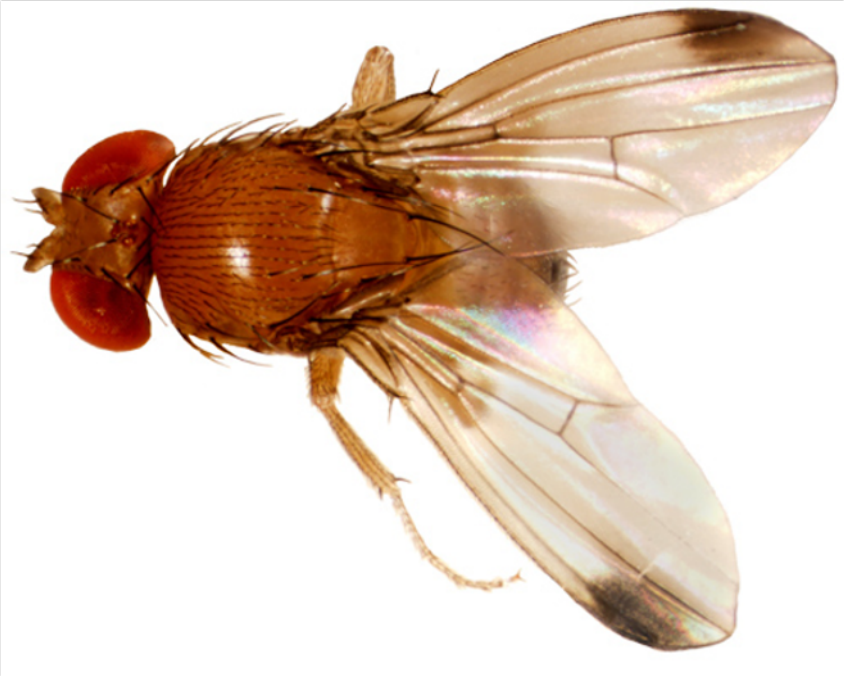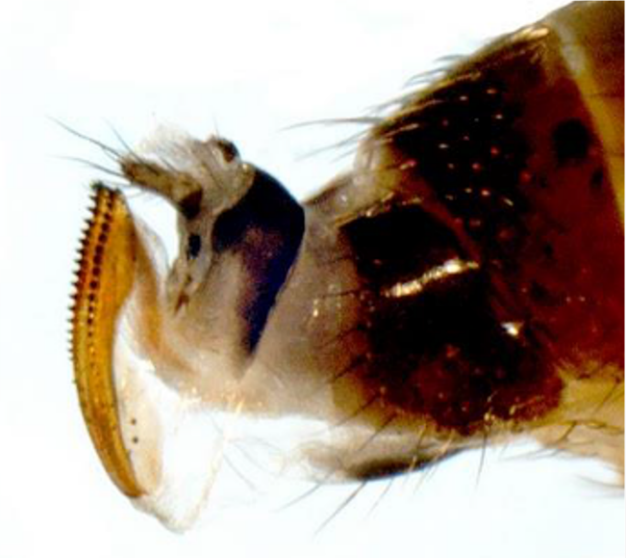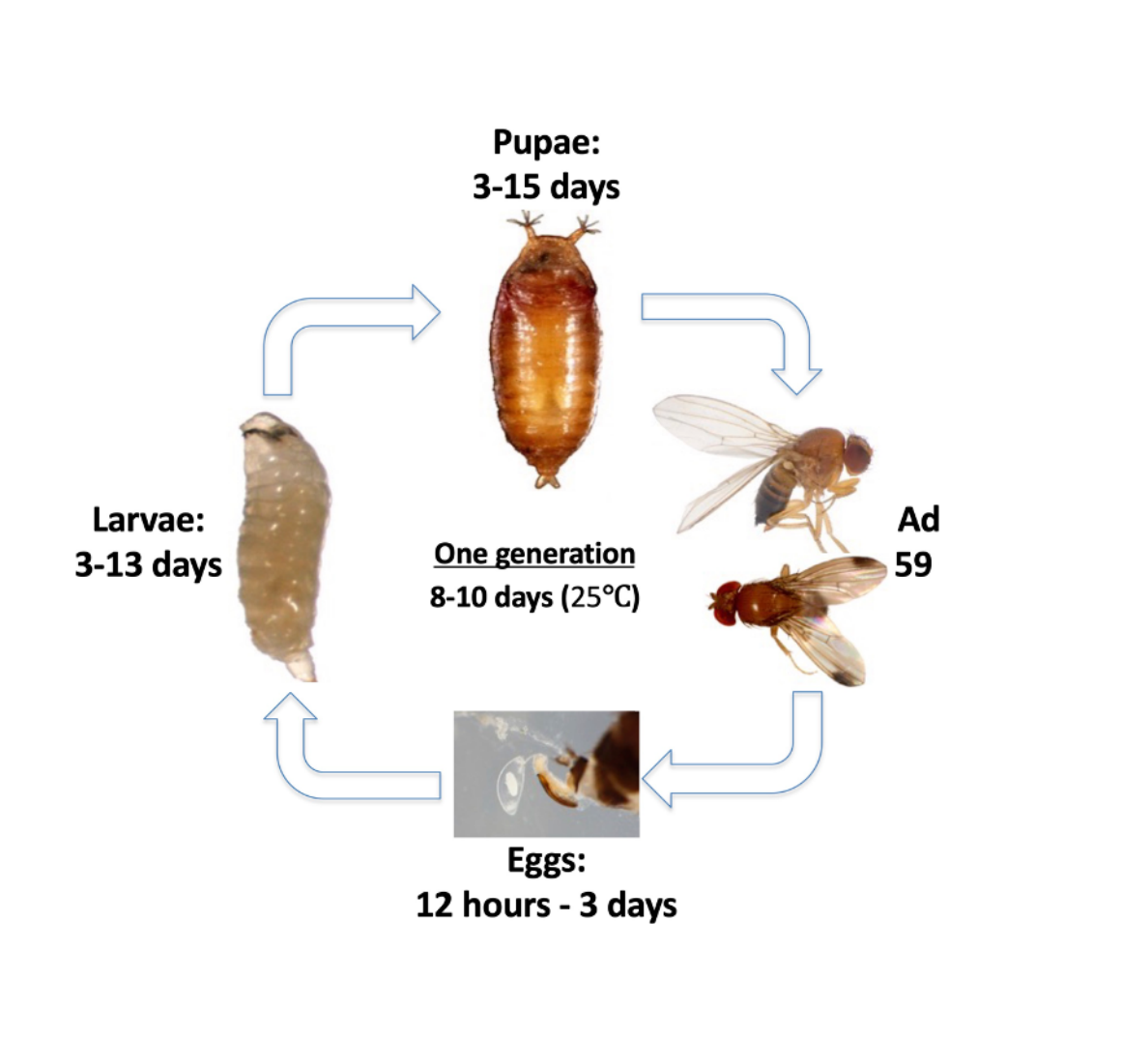Drosophila suzukii (Matsumura)
Author: Ash Sial, Entomologist, University of Georgia, 2022
Description
Immature stages: Larvae are white with a cylindrical body that tapers on one end, only 1/8”.
Adult stages: Adults have a brownish-yellow thorax, black stripes across the abdomen, and distinct red eyes. Males have dark spots on wingtips and black combs on forelegs. Females lack the spots and black combs, but have a very large serrated ovipositor, a long organ used for laying eggs.


Biology
Life Cycle: The adult female punctures the skin of intact fruit using its serrated ovipositor and deposits eggs just under the fruit skin. Two spiracles (breathing tubes) which are attached to the egg extend out of the fruit through the hole, also known as a sting. Eggs hatch after 1-3 days and the larvae continue to feed inside the fruit. While in the fruit, larvae develop through three instars. After 5-7 days, the third instar exits the fruit to pupate. The puparium is initially bright white but turns brown with age.
The fly remains in its puparium for 3-15 days until the adult emerges. Adult males may not develop the characteristic spot on the wingtips until 10 hours after closing, and reproductive maturity will typically be reached after 1-2 days. Mature females are extremely productive, laying 1-3 eggs per oviposition site, in 7-16 sites per day, for 10-59 days. One female
can produce 300-600 eggs within a lifetime
Distribution: Native to southeast Asia, this invasive vinegar fly is found in most of the primary fruit growing regions of the U.S.
Damage
Fruit are susceptible to SWD damage as soon as the maturing fruit begin to change color up until they are harvested. Typical vinegar flies infest damaged, overripe or rotting fruit for egg-laying, but a female SWD can lay eggs into intact fruit using its serrated ovipositor. Although the fruit receives some damage during egg insertion which increases its vulnerability to fruit pathogens, the majority of the damage is caused by larval feeding. Larvae eat the fruit pulp causing fruit to collapse often within days of egg-laying.

Management
Monitoring should be in place from early stages of fruit development until the end of harvest. Several trap designs will help determine the presence of SWD. Traps should be hung in shaded areas of the canopy in the fruiting zone. Keep traps clear of vegetation with holes exposed so flies can get inside. Check traps at least once a week and add fresh yeast-sugar bait each time. Sampling fruit prior to harvest will determine level of infestation by extracting larvae in one of three methods: sugar, salt, or boiling.
Remove over-ripe or fallen fruit from the field and dispose of them properly as well as wild plants with berries that can be potential hosts. Frequent harvest intervals keep susceptible fruit off bushes. Netting with mesh size less than .98mm can also protect fruit from flies.
If infested berries are found in the field or at the processor, they should be bagged inside plastic bags to prevent fly escape and placed in the sun to kill SWD before they complete development and emerge to continue infesting more fruit. If there is a large pile of fruit, it can be solarized by placing clear plastic sheet over the fruit in a sunny location and sealing well around the edge using soil. Keeping berries cool during the supply chain from processor to market to consumer will minimize the chance of larvae development.
When administering pesticides, growers should ensure they are providing thorough coverage to the fruit and all areas of the bush. Insecticides registered for organically produced blueberries are less effective against SWD than conventional insecticides and have shorter residual activity. Make sure to rotate classes of insecticides to delay the development of insecticide resistance. However, flies can be managed successfully through more intensive monitoring, timely and frequent application of the available insecticides. Cultural control strategies will also be important to help reduce the overall population levels and should be implemented whenever possible.
